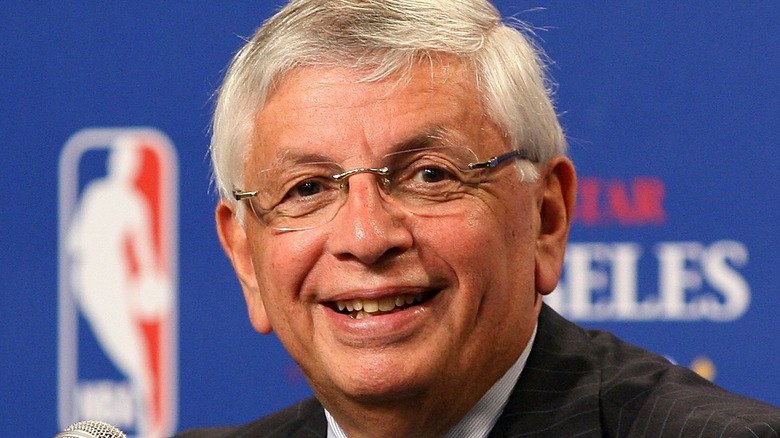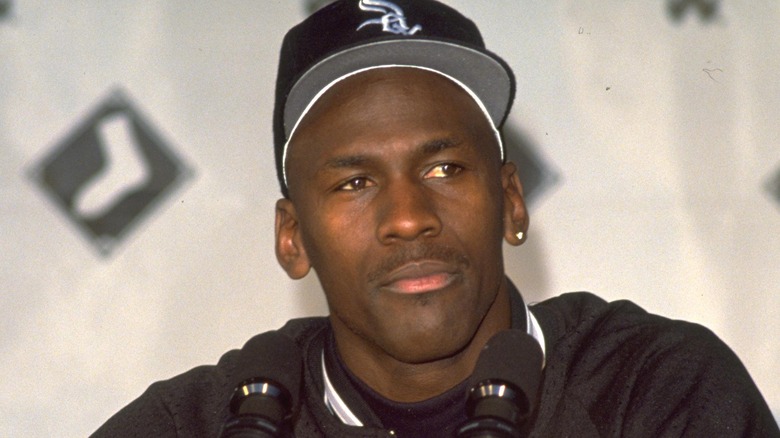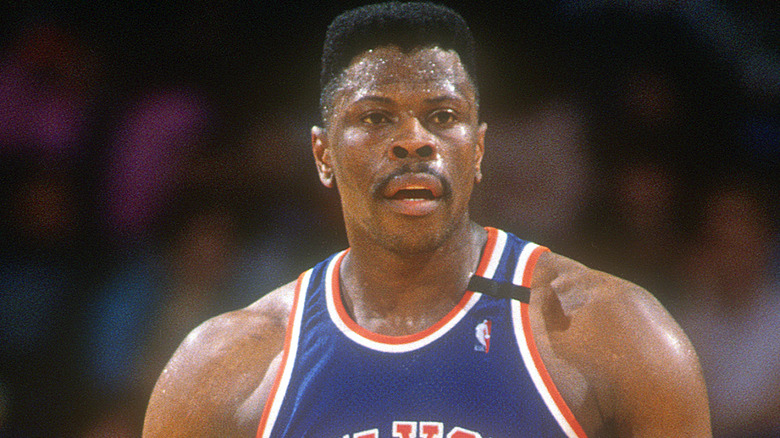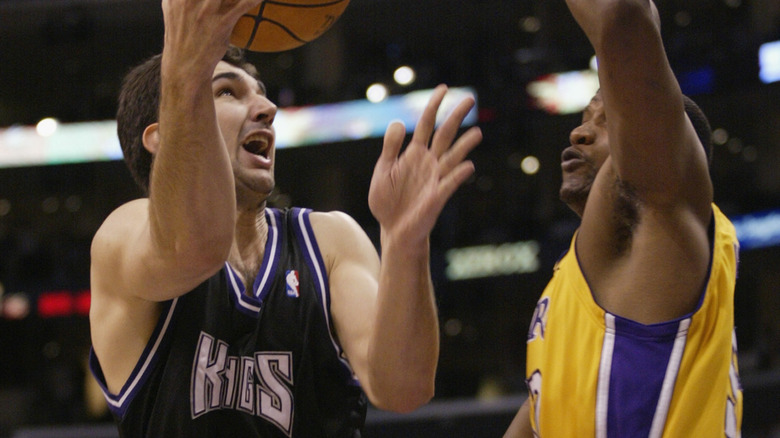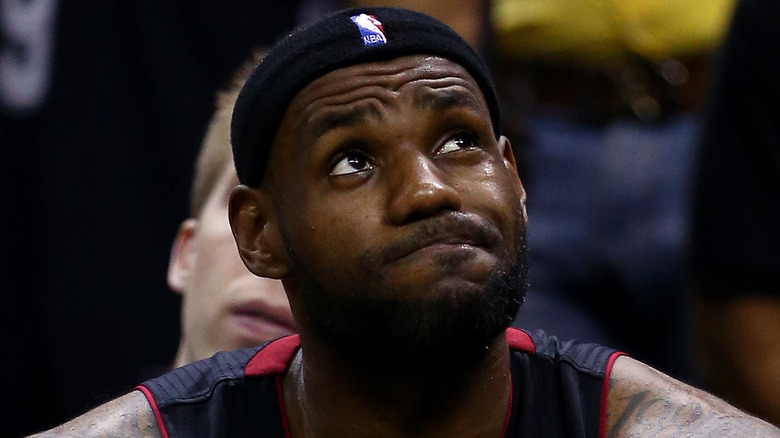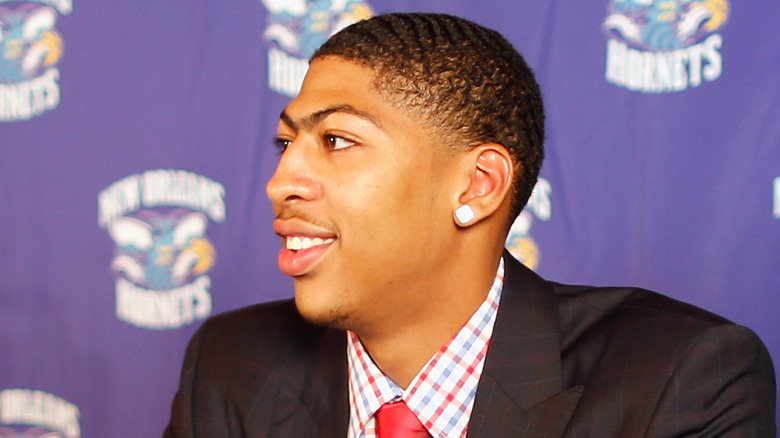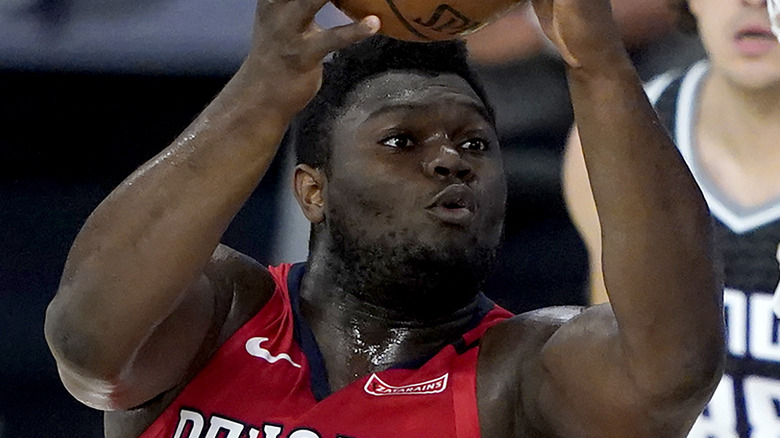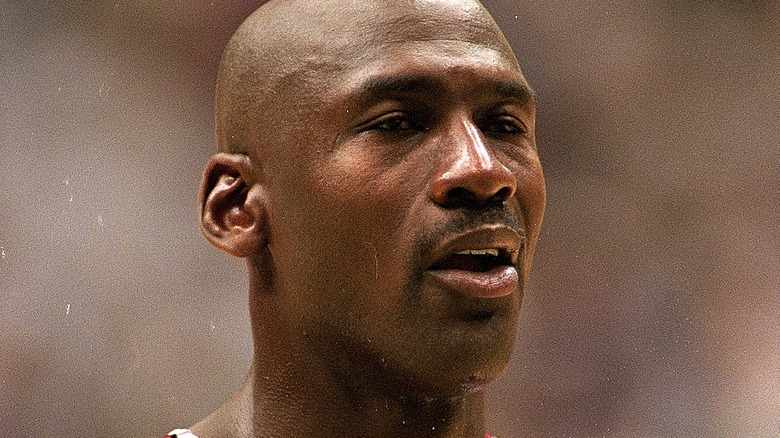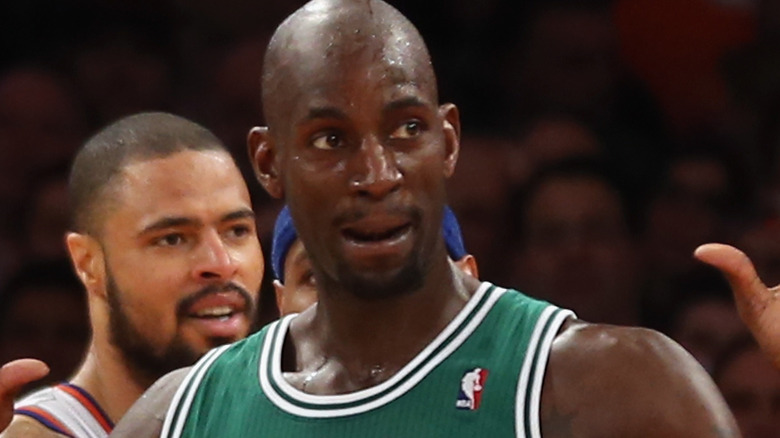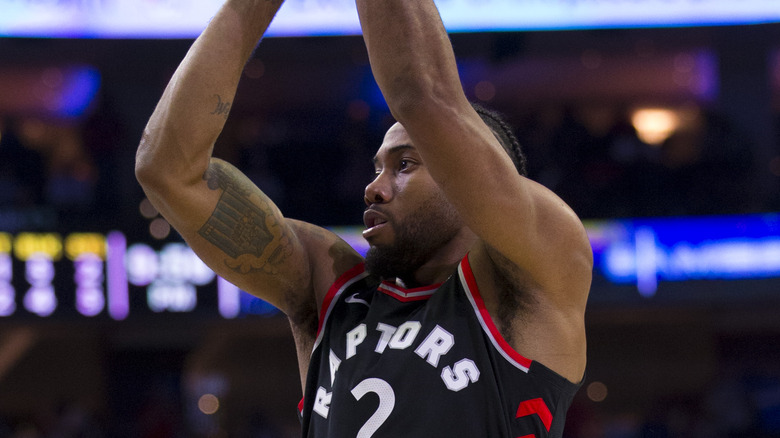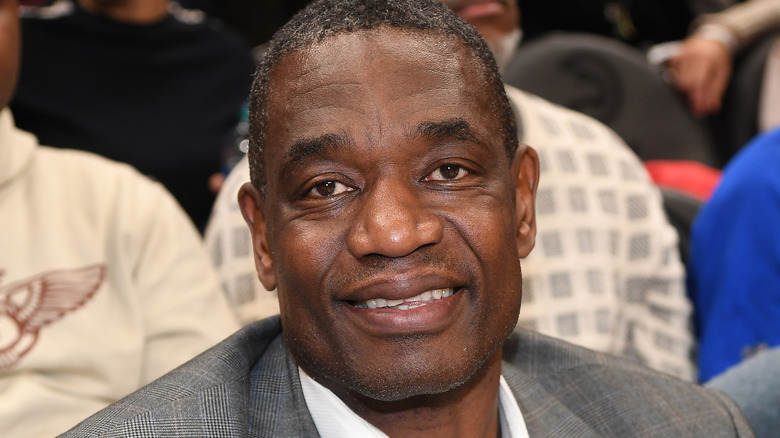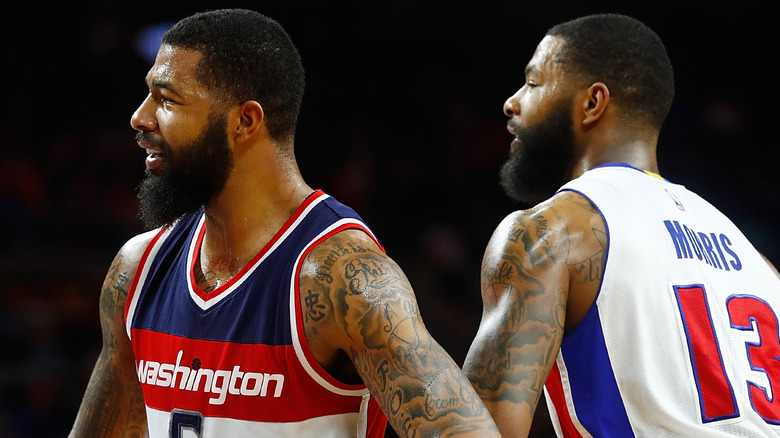The Biggest Conspiracy Theories About The NBA
It's one of the "big four" leagues of North American team sports, and it generates billions of dollars each year in revenue for itself, its 30 franchises, and its internationally known roster of superstar players. Yes, the NBA is a big, bright business, an institution of sports and a big draw in terms of both live entertainment and TV broadcasts. The league literally has a board of governors and a commissioner, so it's ruled over and operated by a quasi-governmental bureaucracy while also acting as a business and a collective of other, independently owned teams.
That makes for a complicated structure involving both money and power, and that is only going to lead to suspicion among the more critical or creatively thinking members of the league's vast fanbase. Many people think that to maintain its prominence and to continue making as much money as it does, the NBA and its operatives simply must be up to something, scheming behind the scenes to ensure the outcomes that it wants and keeping the public in the dark and happy. Here, then, are all the juiciest conspiracy theories ever floated about the National Basketball Association.
Michael Jordan didn't temporarily retire — he was suspended
In October 1993, shortly after winning his third NBA title in a row with the Chicago Bulls, Michael Jordan abruptly retired. "The desire is just not there any more," Jordan said (via the Los Angeles Times). What's even more shocking: He was quitting basketball in favor of baseball. According to ESPN, Jerry Reinsdorf, owner of the Bulls and baseball's Chicago White Sox, signed Jordan, who never got any higher than the team's minor league affiliate, the Birmingham Barons. Near the end of the 1994-95 season, Jordan ultimately returned to basketball (via The Sporting News) and eventually won three more championships with the Bulls.
Early retirement, baseball, coming out of retirement, and returning to world-class play: It all just didn't make sense for some conspiracy theorists. The real reason Jordan disappeared from basketball for a year-and-a-half: He was secretly suspended by the league over gambling issues, and retirement and baseball were a cover story to protect its highly marketable golden goose.
In 1992 (per Bleacher Report), Jordan admitted in court that he'd racked up huge gamblings debts to convicted drug dealer James Bouler. Months later, Richard Equinas wrote in his gambling addiction memoir that he'd won nearly $1 million in betting on golf games with Jordan. The NBA investigated Jordan's gambling activities for rule violations in summer 1993 ... just before he retired.
The 1985 draft lottery was rigged
Until 1984, the order of the NBA Draft was determined by record: The worse a team, the higher their pick, with No. 1 going to the winner of a coin flip between the worst of each conference. Several teams, according to Sports Illustrated, seemed to purposely play badly toward the end of the year, tanking a foregone season to ensure a higher draft pick. The NBA's board of directors acted to create a draft lottery in 1985: Non-playoff teams had their names written on envelopes and placed in a box, and commissioner David Stern would pull them out at random.
Prior to the 1985 draft, every team wanted Patrick Ewing, Georgetown's explosive, versatile center. Whoever got Ewing would certainly see increased ticket sales and TV ratings, but if he landed in a smaller market, like Sacramento or Indiana, it wouldn't do much for the NBA overall, which was in the middle of renegotiating a TV contract. And so, the No. 1 pick in the 1985 draft, used on Ewing, went to the New York Knicks, a storied team with a huge fanbase and based in the NBA's biggest market.
That was just too perfect for conspiracy theorists, who believe that the NBA ensured the Knicks would get the pick by rigging the lottery. Supposedly, Stern didn't pick an envelope at random, but fiddled around until he found one that was cold to the touch — frozen beforehand so he knew which one had "Knicks" written on the inside.
The 2002 Western Conference Finals were rigged
The Los Angeles Lakers won the NBA Finals in 2000 and 2001, but to attempt a three-peat in 2002, they'd have to beat the Sacramento Kings in the Western Conference Finals. According to a conspiracy theory floated by a former NBA referee, the Lakers winning out over the team who captured the Pacific Division title by nine games was almost a foregone conclusion. Tim Donaghy, convicted of felonies for betting on games he helped officiate, told The Daily Beast that the NBA routinely conspired to help "league-preferred" teams — meaning the most popular and profitable ones — win big. The Lakers in the Finals, led by household names Kobe Bryant and Shaquille O'Neal, would ensure a much more lucrative one than a matchup featuring the small-market Sacramento Kings, with Chris Webber and Mike Bibby.
Believers of the theory point to a mountain of questionable and even baffling ref calls in Game Six of the 2002 WCF, such as Webber's block of a Bryant shot called a foul despite a lack of contact, and Bryant elbowing Bibby so hard he got a bloody nose but receiving no foul call. The Lakers scraped out a win in that game, and they took the series in the decisive seventh game. NBA commissioner David Stern rejected all of Donaghy's claims as the untrustworthy rantings of a disgraced "rogue official."
The Spurs hurt LeBron James on purpose in the 2014 NBA Finals
In 2014, the San Antonio Spurs defeated the Miami Heat to win the NBA Finals, reversing the result from the previous season's championship round. The Spurs cruised to a four-games-to-one victory, establishing the tenor with a 15-point win in the first game, in which Heat superstar LeBron James left early, succumbing to a thigh cramp early in the fourth quarter. "It was the whole left leg, damn near the whole left side," James told ESPN, blaming a rapid dehydration because "it was extremely hot in the building." During the game, he was overheard telling other members of the Heat that the Spurs were "trying to smoke us out of here." He received IV fluids during the game and changed into a new, non-sweat-drenched uniform at halftime.
According to The Guardian, AT&T Center in San Antonio had a broken air-cooling system, which some conspiracy-oriented NBA fans think was purposely disabled on order by Spurs coach Gregg Popovich — specifically to make James so physically uncomfortable and ill that he couldn't put up the big numbers he usually did, tilting the game in the Spurs' favor. The theory falls apart pretty quickly — Miami Heat coach Erik Spoelstra thought it absurd, and several winning Spurs players commented on how tough it was to play in the sweltering heat.
The NBA rigged the 2012 draft lottery to appease New Orleans
According to the New York Times, the NBA bailed out the financially disastrous New Orleans Hornets franchise in 2010, buying the team for $300 million and making it a ward of the league. The NBA flipped it to businessman Tom Benson. According to ESPN, Benson was contracted to keep the team in New Orleans for at least 12 years, but at the time that the order and lottery for the 2012 NBA Draft was determined, the sale hadn't finalized yet. Even though they had just the fourth-best shot of landing the No. 1 pick, per the Washington Post, the Hornets won the draft lottery — meaning the NBA gave the team it owned the best pick, widely speculated to be used to grab Kentucky superstar Anthony Davis (which the Hornets ultimately would). Immediately, executives from other teams cried foul, citing a conspiracy in the NBA front office to maximize the value of the Hornets and give the Benson era a jumpstart.
"It's such a joke that the league made the new owners be at the lottery for the show," an anonymous team executive told Yahoo! Sports. "The league still owns the Hornets." And according to Business Insider, the impropriety was out in the open — a photo of Anthony Davis wearing a Hornets cap circulated two weeks before the lottery.
The 2020 bubble teams were handpicked to juice TV ratings
After the 2019-2020 season was abruptly postponed in March 2020 during the spread of the coronavirus, the NBA reconvened months later to play out the remainder of the regular season and the playoffs in lockdown, or a "bubble" — teams and staff would be confined to the campus of Disney World in Florida, according to ESPN. But not every NBA team would make the trip, per CBS Sports — 22 of the league's 30 teams made the cut, nine from the Eastern Conference and 13 from the Western Conference. The NBA didn't want to have more personnel than was necessary, so it only invited the teams in contention for one of each conference's eight playoff spots. The 10th-in-the-West New Orleans Pelicans got to go, led by heavily touted rookie Zion Williamson, the No. 1 draft pick out of Duke and a sensation for his thunderous dunks and agile play.
According to a conspiracy theory (discussed by the Los Angeles Times) the bubble structure had little to do with playoff contention. The NBA wanted to boost attention, and subsequently TV ratings for, its bubble experiment. So, it made sure to come up with a format that would get the popular and alluring Williamson into the spotlight as much as possible. The league publicly attested that the rookie had nothing to do with anything, and that it just wanted to bring in worthy teams and play games in a safe environment.
Michael Jordan's 'Flu Game' was really a food poisoning kept under wraps
While Michael Jordan amassed an unbelievably long list of achievements in his NBA career, the 1997 "Flu Game" is one of the most impressive, and controversial. In Game Five of the 1997 NBA Finals, with his Chicago Bulls tied with the Utah Jazz at two games each, Jordan irrevocably turned the tide for his team, winning the match thanks to his 38-point performance (including a last-minute three-pointer). All the more impressive: Jordan evidently had the stomach flu during the game. "I was really tired and very weak," he told NBA.com, adding that he felt dehydrated, couldn't breathe at times, had little energy, and considered intravenous fluids. While that certainly added to the well-crafted Jordan hero mythos that fueled the NBA's PR machine for years, the truth may have something to do with a conspiracy to take down the superstar.
In 2013, Jordan's personal trainer Tim Grover told TrueHoop TV (via ESPN) that on the night before Game Five, Jordan ordered a pizza to his Utah hotel room and it was suspiciously delivered by five guys. Only Jordan ate the pizza, and in the middle of the night, the superstar was "curled up in the fetal position." In other words: Jordan had food poisoning from a deliberately tainted pizza, not the flu. In the 2020 documentary "The Last Dance," Jordan himself asserts the theory that he was poisoned.
Kevin Garnett went to Boston so he wouldn't go to the Lakers
The rivalry between the NBA's Boston Celtics and Los Angeles Lakers is one of the most intense and enduring in all of sports. Including the Lakers' time in Minneapolis in the early years of the NBA, the teams have squared off in the Finals 12 times; several of those meetings came in the 1980s, with little love lost between Magic Johnson's Lakers and a Celtics team led by Larry Bird and Kevin McHale.
After the end of his playing days, McHale became the Vice President of basketball operation for the Minnesota Timberwolves, and in 2007, he helped facilitate the huge trade that sent star Kevin Garnett to the Celtics in exchange for five players and two draft picks (per The Sporting News). According to the Boston Herald, Garnett landing in Boston was something of a surprise — intel suggested that Garnett would be traded to the Phoenix Suns or the Lakers. And thus a conspiracy theory developed: Ex-Celtics great Kevin McHale supposedly worked aggressively to get Garnett to Boston if only so his old rivals in LA couldn't have him. Larry Bird thinks those rumors are nonsense. "Garnett ... didn't want to leave ... Kevin didn't want to trade him," he said. "I think other people got involved at the last minute." (Nevertheless, and coincidentally, in the next NBA Finals, a Garnett-powered Celtics won the whole thing, defeating ... the LA Lakers.)
The NBA uses magnetic rims to ensure outcomes
It was probably the single most exciting moment of the 2019 NBA playoffs. The Eastern Conference Semifinals between the Philadelphia 76ers and Toronto Raptors came down to a seventh and decisive game, with the score tied at 90 with four seconds left. Kawhi Leonard got the ball for Toronto and drove in for a mid-range jumper. Released before the buzzer sounded, the ball bounced high off the rim, then several more times before finally falling in and giving the Raptors the win and an entry to the Eastern Conference Finals.
It was such a cinematic, dramatic ending, combined with the weirdness of the ball bouncing so much and for so long, that some conspiracy-minded NBA watchers thought that it could only have come about through careful staging and the use of diabolical technology. According to The Score, in the days after Leonard's miraculous game-winner, YouTube and Reddit were inundated with posters suggesting that magnets hidden in the ball and the rim worked together to make the shot go in. Deadspin reported that some people think the NBA regularly controls games and determines their outcome via embedded magnets in the equipment. That sports news site consulted with Drexel University physics professor Dr. Michael Vogelev, who dismissed the idea. "It went in because Leonard put an unusually high trajectory on the ball," he said. "Usually a front rim shot clanks off or skips over. Here it bounces almost straight up."
A tweet by Dikembe Mutombo supposedly exposed rigged draft lotteries
Dikembe Mutombo is one of the NBA's best and most memorable players, shaking his finger and muttering "no, no, no!" after rejecting a shot, something he did hundreds of times in his Hall of Fame, 18-year career, which included a two-season stint with the Philadelphia 76ers in the early 2000s. In May 2016, retired and working as an NBA global ambassador, Mutombo tweeted (via SBNation) a photo of himself and 76ers teammate Allen Iverson from his playing days along with the message, "Congrats to @Sixers on grabbing the #1 spot in the #NBADraft. #PHILAfirst."
The Philadelphia 76ers won the NBA Draft lottery that year, but the problem here is that Mutombo fired off that tweet before the lottery selections were made. That led to cries of conspiracy, that the NBA had rigged the draft in favor of Philadelphia (who had the best shot at winning the No. 1 pick anyway, because they had the worst regular season record in 2015-'16). Mutombo told the Associated Press (via NBC Sports) that there was nothing untoward or sneaky about his tweet. "I want to let people know there was no conspiracy," he said. The 76ers had reached out to him before the lottery, asking him to tweet out congrats if they landed the No. 1 pick. He drafted the message and accidentally posted it too soon. "It was like maybe 30 seconds, then I realized, 'Whoa! What did I do here?'"
Markieff and Marcus Morris pulled a switcheroo
Markieff Morris and Marcus Morris are the rare set of identical twins to play in the NBA. They were drafted back-to-back (13th and 14th, respectively) in the 2011 NBA Draft, they both play power forward, and they've averaged around the same points-per-game. An odd conspiracy theory, which sounds like the plot of a basketball-themed "Sweet Valley High" novel, contends that one of the twins once pretended to be the other. According to The Ringer, Markieff Morris played just 11 minutes for the Washington Wizards in a 2017 Eastern Conference Semifinal series against the Boston Celtics. While going up for a shot, he brutally sprained his ankle after getting tripped up by defender Al Horford. And yet two nights later, Morris returned to the Wizards and scored 16 points showing zero indication of injury.
NBA fans speculated that Markieff Morris didn't play in that game at all — it was Marcus Morris, of the previously eliminated Detroit Pistons, who suited up for his twin in his stead. Some extra proof: A widely-circulated photo of Marcus wearing Markieff's Wizards jersey at the game site on the day of the game in question. There's also the fact that they switched before. "We did it before in AAU ball," Markieff Morris told AZ Central in 2013 (via The Ringer). "He had hurt his ankle but I had fouled out. I gave them a little limp back in, like I was hurt and kept playing."
